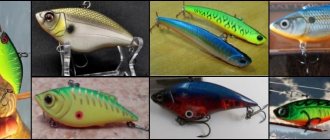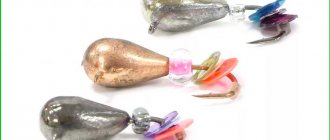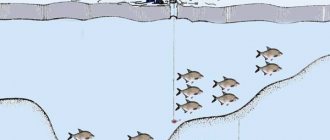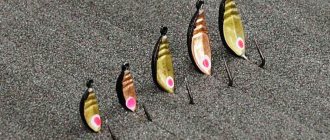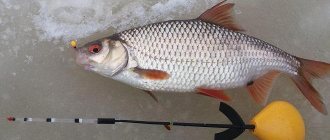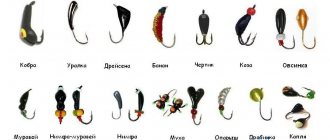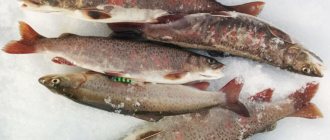Those fishermen who know how to fish with a baitless jig are respected by the entire fishing community. After all, this is an entire art and it is necessary to master it, just like any type of activity. Just coming and catching it won't work. Some, having lost faith in the effectiveness of this method, give up their idea. But those who understand the rules of the game will be rewarded with a good catch. How experienced fishermen use baitless jigs, watch the video.
Fishing with a baitless jig follows the rules. The goal of the game is to imitate the movement of an insect, but this must be done in such a way that the fish does not recognize the deception. In order for the game to be successful, you need to learn. It will be difficult for beginners to fish with such bait at first.
Operating principle
The catchability of a jig is based on the following factors:
- the basis is a sinker (different in shape, design and materials), to which a hook is attached (single, double or tee, different in size);
- through a hole in the load, or a special loop, it is tied to the fishing line;
- Due to the correct twitching, the movement along the bottom of various insects or mollusks that are of edible interest to fish is imitated.
A special property of the baits described is that they absolutely do not require any bait. Its versatility lies in the fact that it can be used for fishing in both winter and summer.
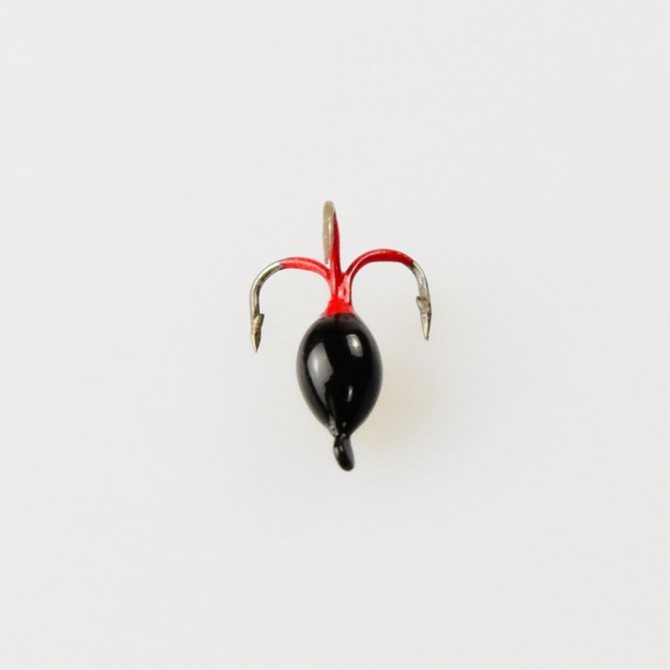
Do-it-yourself subtleties
Anglers who decide to create their own homemade reelless reel should understand that a painstaking process awaits them, requiring a responsible approach. To ensure that the final result does not bring disappointment, it is important to take into account the main subtleties and recommendations. These include the following points:
- It is not customary to fish in winter with a bare hook. Therefore, instead of live baits, additional accessories are placed on reelless jigs, including beads and cambrics with different shades. Products are created from various raw materials, but so that they can float freely in the water column, it is advisable to use foam or plastic.
- To fill the mold with solder or lead, you should use soldering equipment with a power of 40-60 W. Before starting work, the workpiece is carefully cut into several small sections, adding soldering acid to them. Once the pouring is complete and the mold has cooled, it should be rinsed well with water and dishwashing detergent. For more productive operation of the soldering iron, it needs to be wrapped in several layers of foil or asbestos. You can also try applying a layer of asbestos, and then a layer of foil on top of it. Of course, you can avoid these steps by using a professional tool.
- When looking for hooks for a homemade jig, it is advisable to use high-quality models with an elongated shank. They should have enough space to install additional accessories, including beads.
- We must not forget about the need to maintain a certain angle of attachment of the bait to the main fishing line. Otherwise, the product will cease to be effective and will turn into a useless piece of metal. To achieve the ideal angle, it is enough to move the hole to the back side relative to the body. Sometimes craftsmen replace these holes with wire loops. The main thing is to choose the appropriate diameter.
- As for the nozzles, you can use old plastic cases from ballpoint pens.
Winter nozzle jigs
They can be called the ancestors of ice fishing, because it arose to catch passive fish in the winter, when activity is very low. And for this purpose they combined the sinker and the hook. The basic principle of their classification is related to weight:
- light weight (for fishing in shallow places and where there is no current),
- average (they are also called universal, if you have some experience you can fish under any conditions),
- heavy (due to their weight, they are convenient for use in areas with fast currents or great depths).

Undoubtedly, jigs made from tungsten blanks are recognized as the best for their distinctive properties:
- quick descent to the bottom while maintaining a stable position,
- feature of the game, so attractive to fish,
- at the same time they are small in size (due to the high density of the material),
- reliable and durable.
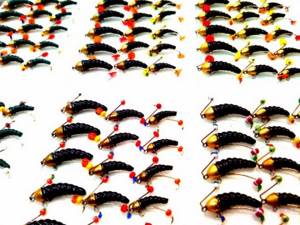
Common myths about bait
Since the appearance of baitless bait on the market, a lot of time has passed until it found its audience of buyers and became popular.
Initially, experienced fishermen did not recognize the invention, because numerous rumors and myths circulated around it, which had no scientific evidence.
These include the following speculations:
- According to representatives of the “old school”, a reelless jig is not suitable for amateur fishing, because it requires the use of specific techniques. A beginner who does not have experience and relevant skills will simply not be able to figure out how to control the bait, as a result of which he will lose the expected catch. Without a doubt, every fishing activity is a painstaking activity that requires serious approach and skill. And fishing with a reel is no exception. To ensure that the result of a trip to a pond does not disappoint the fisherman, he needs to understand in advance the principle of action of the bait, go through a lot of training and gain a minimum of experience. Hoping for a lucky break and a phenomenal bite from the first throw of the product into the hole is stupid.
- The second myth goes like this: a reelless bait is a bait of a narrow direction that can only attract large prey of a certain breed. There is an opinion that each type of fish reacts to its own bait with unique movements and amplitude. In practice, the situation looks completely different: reelless baits remain effective for finding any representatives of the ichthyofauna, regardless of their breed characteristics or size. The main thing is to choose the right model, guided by the fishing conditions and the expected size of the trophy.
- Lack of bait on the hook reduces the effectiveness of the bait. This principle is defended by many experienced fishermen who engage in winter fishing. In fact, they simply forget about the possibility of using a rewinder during the warm period in open water, when the presence of additional bait on the hook is not a necessary condition. However, during a complete lack of bite, a fragrant bait can increase the chances of at least some activity from the fish. If the inhabitants of the depths are looking for food, then they respond to baitless bait just as well as to the option with a bait, so everything is ambiguous. In some conditions, instead of live bait, multi-colored beads are placed on the hook.
Summer jigs
The difference between a summer jig and a winter jig is not so great. Considering the weather conditions (temperature, windiness, etc.), during this period there is an incredible amount of fry, the use of small jigs is not recommended. In warm weather, large jigs are most relevant.
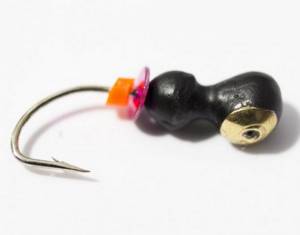
In addition, most of them are colored in red-brown shades (pleasant for crucian carp, pike perch and perch). The species do not differ from winter ones, except that the pattern can imitate the shell and imitate representatives of arthropods.
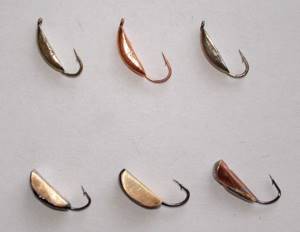
And the most important thing is that you need to approach the selection of a rod, line and nod more responsibly.
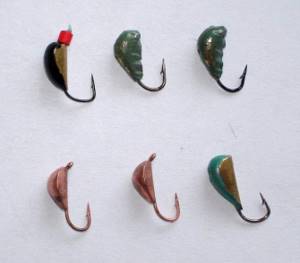
Tips for choosing jigs
When choosing a particular jig, of course, it is better to consult with experienced fishermen to find out on which body of water which is the most catchy. Besides this, other characteristics are also important:
- hooks: strong, sharp and relatively thin (it is better if they are made of steel wire);
- material: the main ones are tin, lead or tungsten; in addition, copper, chromium, silver, brass are used (they are less susceptible to corrosion);
- product color: black (universal, best used in spring); copper and its shades (in depth); cold shades (for clear waters); green and brown (for perch and roach); light colors (for ice fishing, if the river is covered with a thick layer of snow); shiny (early morning) and dull (during the daytime);
- size (weight): at depth or in fast currents, large and heavy jigs will be required, and medium or small sizes with low weight will be convenient when fishing in shallow water (it is better to have jigs of different sizes and weights);
- shape: noticeable, “ball” and “droplet” will be universal (popular in ice fishing), flat creates a lot of turbidity (suitable for roach and perch), conical will sink into the muddy bottom.
Jigs using a nozzle

As already mentioned, there are exclusively nozzle-free options, as well as universal models, which, if such a need arises, can be additionally equipped with a nozzle. In this case, the fishing process will have some differences, which are given below:
- There is no need to look for hungry or active prey, as when using baitless options. All you have to do is discover where the fish are staying, after which you can feed the hole and fish on it all day long. Complementary feeding should be moderate so that potential prey does not become oversaturated, which will reduce the likelihood of bites.
- It is recommended to fish and feed the most promising areas of the reservoir, these include areas with underwater thickets, border areas of flooded channels or rubble of snags. During the absence of severe cold or during the thaw period, it is best to move to shallow water located close to the shore, since a wide variety of prey rush here, for example, rudd, roach and fairly large perches.
- If you want to catch a silver bream or a white bream, it would be best to fish the areas near the wintering pits where these species come to feed. Here you can get a significant catch even without preliminary feeding of the chosen place.
- The most common baits are caddisfly larvae or bloodworms; in some cases, maggots can also show good results. When catching non-predatory fish, you can use semolina.
- The pellets are classic jigs, they have small dimensions and are characterized by a virtually complete absence of their own game. However, after several larvae are attached to them, the bait will begin to make slight characteristic vibrations, which are likely to attract potential prey to the fishing spot. This use of a pellet is most effective if the main prey is perch.
- An integral attribute of bait fishing is the nod. Today, the most successful solution is to use lavsan varieties, since they are highly sensitive and register even the smallest bites, while not being afraid of exposure to low temperatures during winter fishing.
Tying methods
Despite the variety of baitless jigs, there are a couple of methods for tying a line. The determining factor is the presence (or absence) of a hole in the body of the jig.
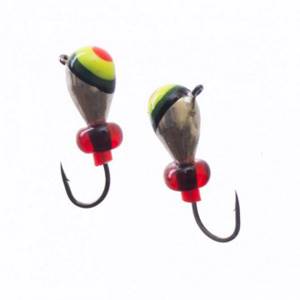
If there is one, then the line is wound through it from the front side, and then tied at the base like a regular fish hook with a self-tightening knot. If there is a special loop or eyelet, then pass it through it.
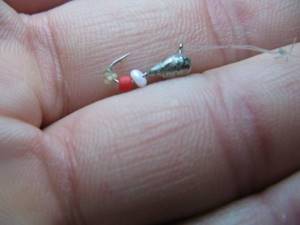
Jig fishing technique
When you take a jig for the first time, you ask yourself the question: how to fish with no-attachment jigs?

Note!
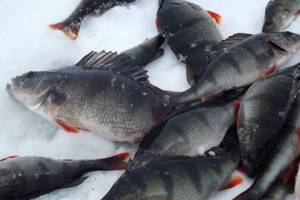
Reelless fishing in winter - secrets and principles of fishing for beginners. 110 photos and videos of winter fishing with a reelless bait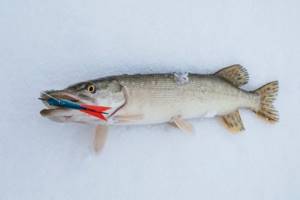
Fishing with a balance beam in winter - a detailed guide and important nuances of fishing with a balance beam during winter fishing (115 photos)
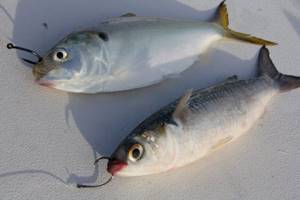
How to attach live bait to a girder - the best methods and step-by-step description of how to properly attach live bait (115 photos and videos)
To achieve the desired result, that is, catch a fish, you must strictly perform the following actions in a certain order:
- immerse the jig in the water,
- lead the bait
- play with bait (special actions that force the bait to move in a certain way),
- hook (necessary for a tighter hook on the fish),
- fish out (carefully lifting a fish caught on a hook by the line),
- removal from the hook (especially if the fish is predatory).
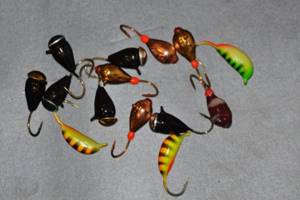
Effects of nozzle jigs
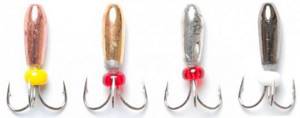
These gears are used mostly in situations where the behavior of the prey is characterized by a sufficient level of activity, and it responds well to the offered bait, since in such cases, baiting bloodworms is only an additional and unnecessary waste of time.
However, fishermen often practice using a baitless jig even when the bite level is low or completely absent, and even in such situations, this tackle can become a real salvation that will attract the attention of the fish.
This is due to the following effects that it creates:
- An active game that makes the fish pay attention to the bait. Such actions and movements can awaken the hunting instinct and provoke even prey that has no appetite to attack.
- Creation of strong acoustic vibrations in the water space, which lures prey to the fishing site even from a very considerable distance.
Particular attention should be paid to baits that are capable of creating the strongest vibrations. These include the following types of nozzle jigs:
- The Uralochka is a classic model, which is distinguished by its versatility, since it can be used both with an additional nozzle and without it at all. The product range is distinguished by its diversity; the main criterion for division is color. Black or tungsten color is considered the standard and most universal, but depending on the individual characteristics of the fishing location and the transparency of the water, other options may be effective. Uralochka shows the greatest effectiveness when catching bream, but is often used for other species.
- The nymph differs from classic jigs in its modified shape, as well as a set of cambrics and plates that are put on the hook to imitate wings. This design allows one part of the bait to be in constant motion, while the other remains in a stationary position. Today, there are different models of nymphs, but the classic option is the yellow-black tackle.
- The kozyulka is very often confused with a nymph due to its similar shape and design, but its fundamental difference lies in its inverted location relative to the hook. This feature allows you to demonstrate an original game with a rather slow descent to the bottom and subsequent rise; roaches are most popular when fishing for roach.
Proper storage
Despite the fact that jigs are made of hard materials, they can be damaged if improperly stored or transported.
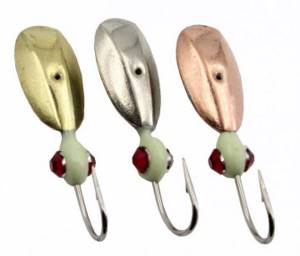
Also, if they are folded incorrectly, they can get caught among themselves and, during fishing, create inconvenience. To do this, use various organizers (tightly closing boxes with a rigid body).

By gluing foam rubber to the bottom of the box, into which if you stick them, they will not cling to each other (accordingly, the hooks will remain sharp, and even more so will not break).
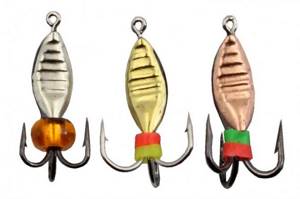
Homemade baits
There is a huge assortment of jigs on sale, but still every self-respecting fisherman fishes with his own baitless jigs, the most catchy ones. He makes them himself or refines an already purchased version and is rightfully proud of his products. The smallest detail can affect catchability. Therefore, the fisherman thinks out his best jigs himself. Many keep the production secret, while others share their homemade products. Therefore, nozzle-free jigs that are made by hand are very much appreciated.
Everyone tries to make the jig smaller, and this must be done masterfully so that it is not too light. Each copy has its own author.
"Universal dolphin"
Author A.Nogateev. Any fish, especially perch, bites on this bait. A removable replant is used, which allows you to use any set. For such a jig, it is better to use a fishing rod with a short whip. This jig should move widely. The ring is offset from the center of gravity. The fishing line is tied with a loop, which allows the bait to move more freely. The technique of playing with such a bait is fast retrieval with a small amplitude and high frequency.
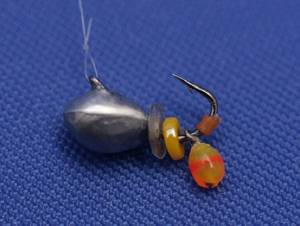
"Universal dolphin"
"Owl"
It is made from plates of copper, brass, cupronickel. First, the workpiece is cut out, then the upper part is bent and a “groove” is made. The wire is twisted into a loop and inserted into the groove. The hook is attached using tin. With tin you need to slightly increase the body of the jig, but so that it is not thick. The jig should be light and stiff. We wash the jig with baking soda to remove the acid used for soldering. Then you need to paint it. There is no need to weigh it down too much. This bait has pronounced body vibrations. You need to play this jig aggressively.
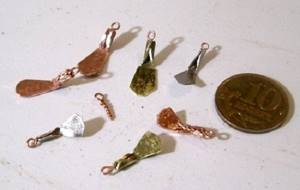
Jigs "Owl"
"Devil"
You can make your own “devil”. To do this, you need to make hooks and wrap them with wire. Watch how this is done in the video:


